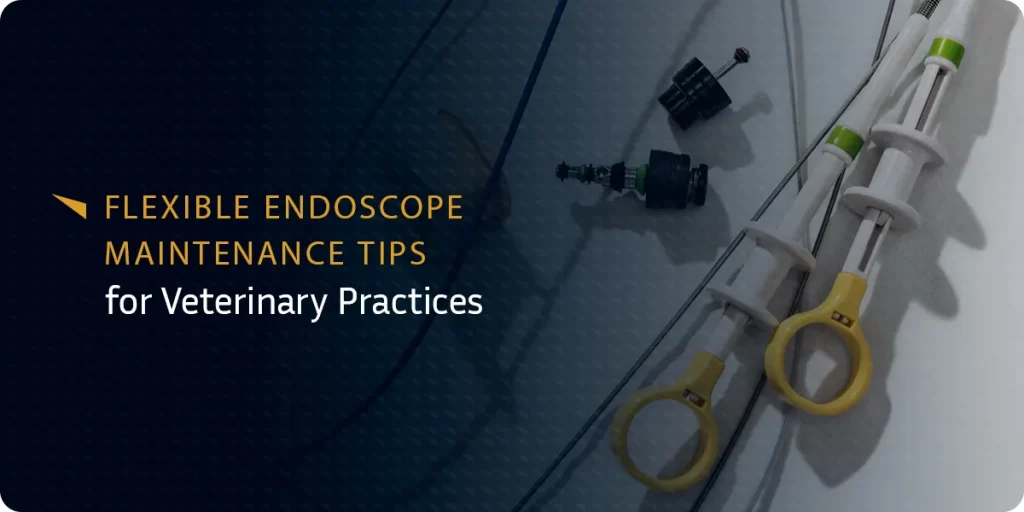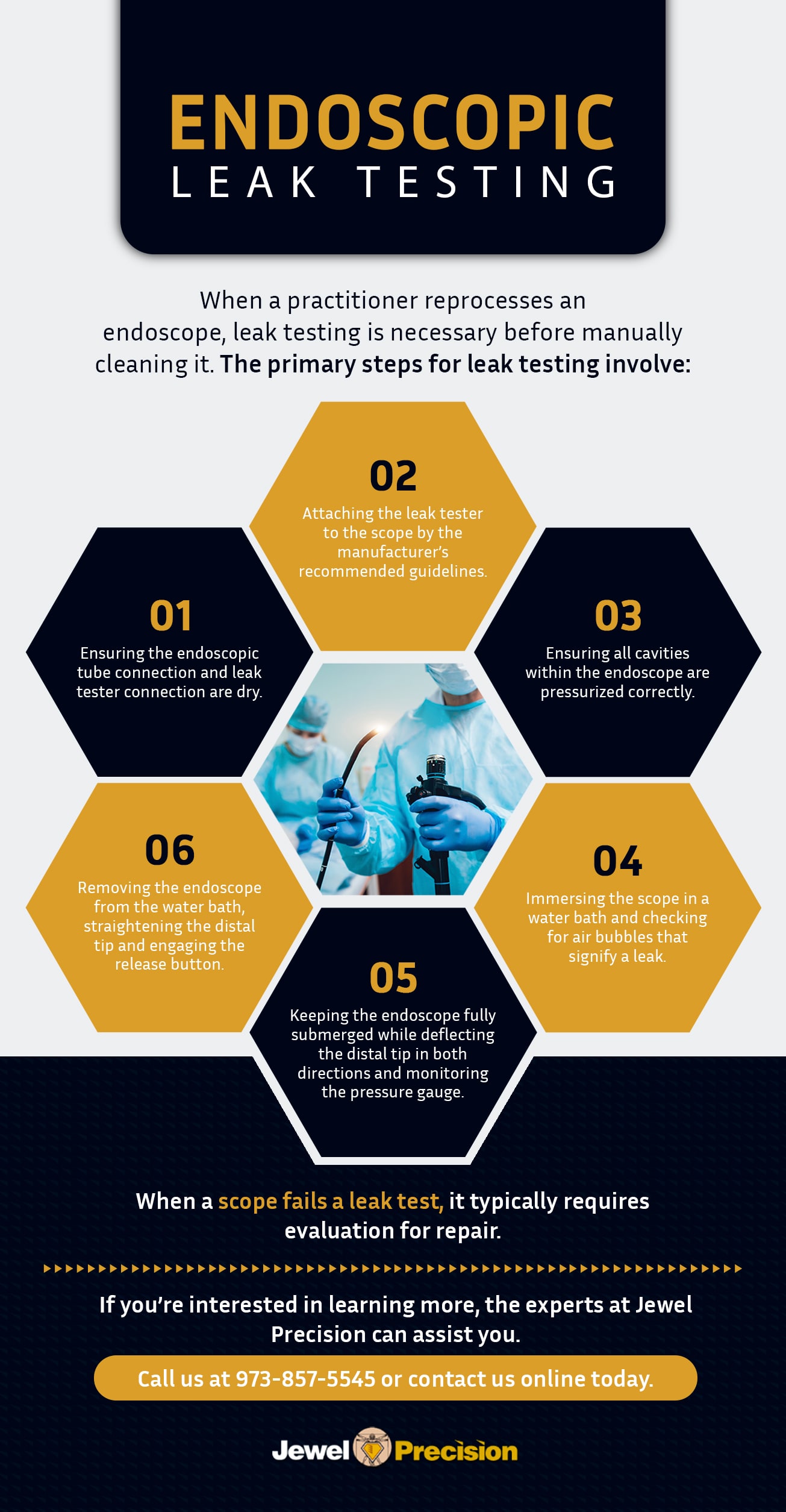
With a growing concern that improperly maintained endoscopes can potentially transmit pathogenic microorganisms, the veterinary industry has increasingly emphasized more effective equipment reprocessing in recent years. Because an endoscope comes into contact with a patient’s vascular system or sterile tissue, they carry a high risk of infection when contaminated. To ensure the highest patient safety levels, practitioners must properly reprocess flexible endoscopes after each use.
Reprocessing a Flexible Endoscope
Infections resulting from improperly cleaned endoscopy equipment represent a significant threat to veterinary practices worldwide. Due to the complexities in their designs, flexible endoscopes require a specialized reprocessing method to prevent infections while ensuring a long service life. Each reprocessing method has several stages for accurate and effective maintenance, from leak testing and manually cleaning the device to sterilization and storage.
Performing each step accurately ensures patient health and safety. Also, choosing high-quality reprocessing equipment from a reputable manufacturer is vital for providing the most effective care and maintenance.
Prepping an Endoscope for Cleaning
During prepping and cleaning, technicians should always wear personal protective equipment, including eyewear, gloves and isolation gowns. Immediately after completion of the endoscopy, the device requires placement into an enzymatic detergent. It is vital to ensure the detergent flows through all nooks and crevices to clear the tube of debris and prevent the formation of biofilm and proteins.
Leak Testing an Endoscopic Tube

When a practitioner reprocesses an endoscope, leak testing is necessary before manually cleaning it. In addition to affecting the scope’s functional performance, leaks or tiny holes can allow fecal matter, blood, secretions and other chemicals to invade the endoscope lining. Besides helping prevent infection, leak testing identifies potential issues early — before they require costly repairs.
The primary steps for leak testing involve:
- Ensuring the endoscopic tube connection and leak tester connection are dry.
- Attaching the leak tester to the scope, following the manufacturer’s recommended guidelines.
- Ensuring all cavities within the endoscope are pressurized correctly.
- Immersing the scope in a water bath and checking for air bubbles that signify a leak.
- Keeping the endoscope fully submerged while deflecting the distal tip in both directions and monitoring the pressure gauge.
- Removing the endoscope from the water bath, straightening the distal tip and engaging the release button.
When a scope fails a leak test, it typically requires evaluation for repair.
Manually Cleaning an Endoscopic Tube
Once a technician confirms the device is leak-free, the next step is to brush the endoscope inside and out with a sponge to ensure thorough cleaning. This process requires removing and scrubbing each valve component. Without appropriate cleaning, sterilization and disinfection will be ineffective, as blood, carbohydrates and proteins left inside the scope provide food and shelter for harmful bacteria.
Using different size brushes and passing them down the channels multiple times is helpful for a thorough cleaning. In addition, sinks and counters require cleaning after this process due to the exposure of potential contaminants.
Visually Inspecting an Endoscope
After manually cleaning the endoscope, the next step is a close visual inspection. This process ensures the device and its accessories are adequately cleaned and free of defects. Magnification devices with lighting are often necessary to detect debris remaining on the endoscope’s surface.
A borescope enables technicians to accurately examine the ports and channels inside the device. Borescopes allow practitioners to detect damage or debris on the endoscope’s internal surfaces that could affect patient safety or the device’s functionality.
Sterilizing and Disinfecting a Flexible Endoscope
Technicians should perform high-level disinfection (HLD) or sterilization according to the manufacturer’s instructions for use (IFU). HLD or sterilization, when executed properly, kills any bacteria, viruses or fungi left over from the manual cleaning process. This stage is critical for preventing the transmission of pathogens and ensuring that a device is safe for use.
Following the manufacturer’s IFU for temperatures and exposure times related to disinfection or sterilization is crucial. In addition, the IFU will specify the types of sterilants or disinfectants required for each device.
Drying an Endoscope
Proper drying before storage is imperative since bacteria can quickly form inside a wet endoscope. A 70% alcohol solution aids in drying and helps eliminate any microorganisms left over from the rinsing process. Purging the device with air after wiping it down kills any remaining germs.
Storing a Cleaned Endoscopic Tube
After drying, technicians should only handle endoscopes with gloved hands. Placing the endoscopes in clean containers before transporting them to the storage areas also helps prevent contamination. Additionally, allowing the scope to hang straight down during storage at the necessary height discourages coiling and other types of damage.
Many practices utilize drying cabinets with high-efficiency particulate air (HEPA) filters that circulate air along the endoscope’s surface and interior channels. These filters help the device stay dry by removing residual moisture.
Documenting the Cleaning Process
Documenting the date and time of endoscope maintenance enables technicians to determine which devices have reached the storage times stated in the IFU. This documentation is essential for quality assurance while ensuring that technicians only use fully reprocessed endoscopes for future procedures.
Learn More About Endoscope Maintenance With Jewel Precision
If you’re interested in learning more about reprocessing and other critical maintenance requirements for your endoscopy tools, the experts at Jewel Precision can assist you. Since 1984, we’ve created advanced case solutions that help veterinary practices optimize their sterilization processes. We set the industry standard for superior product quality, top-class customer service and innovative technology.
Call 973-857-5545 or contact us online today for a quote or additional product information.